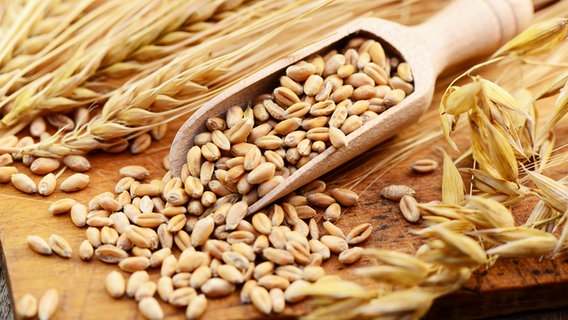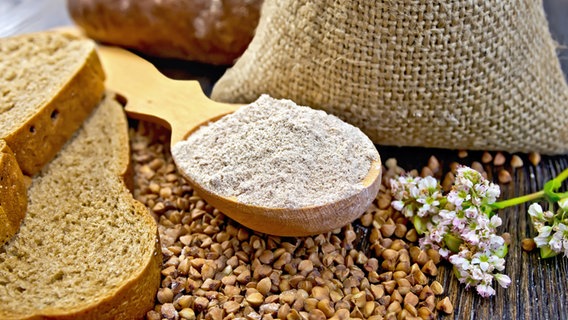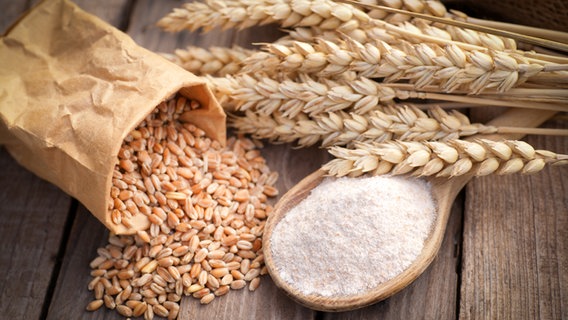Status: 03/03/2023 6:41 p.m
Sales of gluten-free foods are increasing. But only people with celiac disease have to avoid gluten completely. What is behind a wheat allergy and wheat sensitivity?
The gluten protein is a natural component of many types of grain inside the seed. There it supplies the germinating plants with the amino acids and proteins they need to grow. Most cereals contain gluten – for example wheat, rye, spelt and barley.
Only people with a proven gluten intolerance, the so-called celiac disease, have to do without it completely. Nevertheless, more and more healthy consumers are turning to gluten-free products: According to the market research company Nielsen, these generated sales of around 487 million euros in 2021 – an increase of twelve percent compared to the previous year.
Celiac disease: Even the smallest traces of gluten are harmful
Celiac disease is an autoimmune disease that mainly affects the small intestine. The immune system produces antibodies that attack the gluten – but unfortunately also the gut, where they destroy sensitive cells. About one percent of the German population is affected. Most celiac disease patients suffer from digestive problems and nutrient deficiencies, becoming thinner and weaker. Other symptoms such as fatigue and reduced fertility, psychiatric disorders or migraines can also be associated with celiac disease. There is no cure. Those affected must avoid wheat and other gluten-containing foods for the rest of their lives. Even the smallest traces of gluten are harmful.
For example, many gluten-free foods contain starch, corn, sugar, fat, thickeners, and ascorbic acid. The ingredients should ensure a pleasant consistency or serve as a preservative. Compared to conventional products containing gluten, vitamins and fibers are often missing.
“Gluten-free” may increase risk of diabetes
Gluten-free products can therefore have disadvantages for healthy people: For example, people who avoid gluten have an increased risk of developing type 2 diabetes. If, for example, you do without wholemeal bread without reason, you automatically avoid healthy dietary fiber, which is also important for a healthy heart and the body intestines and have a positive influence on blood pressure. “The intake of magnesium or other nutrients such as B vitamins is also limited if people really only use very special types of grain,” warns Antje Gahl from the German Society for Nutrition.
Expensive gluten-free substitutes
Gluten-free foods are significantly more expensive than corresponding gluten-containing foods. The reason: the production is very complex. Any contamination with gluten must be avoided and, last but not least, many companies have their own laboratories to check that their production is gluten-free.
Wheat Allergy: Gluten doesn’t matter
In addition to celiac disease, wheat allergy is mentioned as another clinical picture in connection with grain. Symptoms include flatulence, diarrhea, abdominal pain and fatigue.
In the case of a wheat allergy, the disease can be detected with an antibody test. Those affected react to wheat from the diet, gluten does not play a role. Products with wheat must be avoided.
Wheat sensitivity: What is the impact of ATIs and FODMAPS?
However, there are also people who do not have either of the two diseases mentioned and still have problems when they eat wheat or other grains containing gluten. This is a wheat sensitivity, also called non-celiac non-allergy wheat intolerance. The symptoms are very diverse – from gastrointestinal complaints to fatigue. Diagnostic procedures do not exist to date. There are currently two hypotheses for the symptoms, which still need to be scientifically verified:
ATIs not yet detectable in the body
In connection with ever new high-performance breeds, ever higher-yielding wheat plants, so-called amylase trypsin inhibitors (ATI) are increasingly mentioned as causing disease. These are specific proteins. They protect the grain from predators and play an important role in germination.
They are suspected of triggering inflammation in the intestines and allergies. It is suspected that they would mistakenly activate immune cells – with symptoms such as abdominal pain, diarrhea, but also headaches and dizziness as a result. A study is investigating this.
But the claim that modern wheat breeds contain more ATIs than old wheat species or wheat varieties is wrong. Researchers were able to determine that there is a large variation in the varieties and a significant environmental influence on the expression of ATIs. In addition: ATI is not only found exclusively in wheat, but also, for example, in spelled, barley, millet, buckwheat and soybeans. Einkorn does not contain the known ATIs, but it does contain a similar protein not found in wheat. And: The ATIs are not yet detectable in the human body.
FODMAPs are not only found in wheat
FODMAPs are also repeatedly mentioned as triggers for wheat sensitivity. These are certain sugars and carbohydrates. They are found in fruits, vegetables, cow’s milk and bread. FODMAPs are not processed properly in the small intestine and can lead to digestive problems, but often also other complaints such as joint pain or headaches.
However, FODMAPs – like ATIs – are not only found in wheat. Although doctors suspect a connection between health problems and ATIs, there is no clear evidence on this. These are only expected in the coming years.
Nutritionists from Lübeck have completed a study in which they gave people with irritable bowel syndrome different types of bread to eat. One baked with commercially available wheat flour with a high FODMAP content. The other with a specially developed flour with a lower FODMAP percentage. The irritable bowel patients who received the low-FODMAP bread reacted significantly less with a bloated stomach.
If you want to find out if you are sensitive to ATIs or FODMAPs, you can avoid foods that contain them for a few weeks.
expert on the subject
Further information





